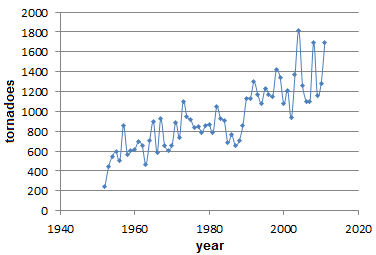Since the early 1950s, the U.S. National Weather Service’s Storm Prediction Center has been collecting tornado data. From 1952 to 2011, there has been a steady increase in the total number of tornadoes reported in the United States annually, largely because of an increase in the number of weak tornadoes (EH0 on the Enhanced Fujita scale). The number of strong to violent (EH3–EH5 on the Enhanced Fujita Scale) tornadoes has remained fairly constant. See also: Tornado
The increase in EH0 tornadoes may be due in part to more accurate tornado observation and detection. But the increase during the last decade of data is not so easily explained because other climate and weather events have increased as well and some of these events have been related to climate change. See also: Climate modification; Recent advances in tornado observations; Storm detection; Weather observations

Researchers from Montana State University analyzed National Weather Service tornado data from 1954 to 2009 for the southern and central U.S. Great Plains (north Texas, Oklahoma, Kansas, Nebraska, east Colorado, and Iowa), also known as “Tornado Alley,” because of its high frequency of tornadoes. Their findings, reported in Geophysical Research Letters (September 2014), showed that during this 55-year period peak tornado activity for the region shifted from May 26 in the 1950s to May 19 in the 2000s; that is, it started seven days earlier. See also: North America
Although the researchers acknowledged that earlier tornado activity could be an expected result of a warmer climate, no apparent connection to global climate change was found for the region. They did find that when El Niño events occurred between January and April, peak tornado activity occurred earlier in the spring in Oklahoma—a smaller but significant linking of global climate change and tornado activity. See also: El Niño; Global climate change





